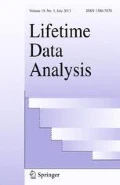Abstract
The increasingreliability of some manufactured products has led to fewer observedfailures in reliability testing. Thus, useful inference on thedistribution of failure times is often not possible using traditionalsurvival analysis methods. Partly as a result of this difficulty,there has been increasing interest in inference from degradationmeasurements made on products prior to failure. In the degradationliterature inference is commonly based on large-sample theoryand, if the degradation path model is nonlinear, their implementationcan be complicated by the need for approximations. In this paperwe review existing methods and then describe a fully Bayesianapproach which allows approximation-free inference. We focuson predicting the failure time distribution of both future unitsand those that are currently under test. The methods are illustratedusing fatigue crack growth data.
Similar content being viewed by others
References
A. C. Atkinson, Plots, Transformations, and Regression, Oxford University Press: Oxford, 1985.
S.P. Brooks and A. Gelman, “Alternative methods for monitoring convergence of iterative simulations,” Journal of Computational and Graphical Statistics vol. 7 pp. 1-22, 1998.
R.L. Carter and M.C.K. Yang, “Large sample inference in random coefficient regression models,” Communications in Statistical Theory and Methods vol. 15 pp. 2507-2525, 1986.
M.J. Crowder and D.J. Hand, Analysis of Repeated Measures, Chapman and Hall: London, 1990.
M.J. Crowder, A.C. Kimber, R.L. Smith and T.J. Sweeting, Statistical Analysis of Reliability Data, Chapman and Hall: London, 1991.
B. Efron and D.V. Hinkley, “Assessing the accuracy of the maximum likelihood estimator: observed versus expected Fisher information (with comments),” Biometrika vol. 65 pp. 457-487, 1978.
A.E. Gelfand, S.K. Sahu and B.P. Carlin, “Efficient parametrizations for generalized linear mixed models,” in Bayesian Statistics 5, pp. 165-180, eds. J.M. Bernardo, J.O. Berger, A.P. Dawid and A.F.M. Smith, Oxford University Press: Oxford, 1996.
A. Gelman, J.B. Carlin, H.S. Stern and D.B. Rubin, Bayesian Data Analysis, Chapman and Hall: London, 1995.
A. Gelman, F.Y. Bois and J. Jiang, “Physiological pharmacokinetic analysis using population modelling and informative prior distributions,” Journal of the American Statistical Association vol. 91 pp. 1400-1412, 1996.
W.R. Gilks, S. Richardson and D.J. Spiegelhalter, Markov Chain Monte Carlo in Practice, Chapman and Hall: London, 1996.
F. Giesbrecht and O. Kempthorne, “Maximum likelihood estimation in the three-parameter lognormal distribution” Journal of the Royal Statistical Society Series B vol. 38 pp. 257-264, 1976.
S.J. Hudak, A. Saxena, R.J. Bucci and R.C. Malcolm, “Development of standard methods of testing and analyzing fatigue crack growth rate data.” Westinghouse R & D Center, Westinghouse Electric Corporation, Pittsburgh, PA, Technical Report AFML-TR-78-40, 1978.
N.M. Laird and J.H. Ware, “Random effects models for longitudinal data,” Biometrics vol. 38 pp. 963-974, 1982.
E.P. Liski and T. Nummi, “Prediction in repeated-measures models with engineering applications,” Technometrics vol. 38 pp. 25-36, 1996.
J.C. Lu, J. Park and Q. Yang, “Statistical inference of a time-to-failure distribution derived from linear degradation data,” Technometrics vol. 39 pp. 391-400, 1997.
C.J. Lu and W.Q. Meeker, “Using degradation measurements to estimate a time-to-failure distribution,” Technometrics vol. 35 pp. 161-174, 1993.
C.J. Lu, W.Q. Meeker and L.A. Escobar, “A comparison of degradation and failure-time analysis methods for estimating a time-to-failure distribution,” Statistica Sinica vol. 6 pp. 531-546, 1996.
W.Q. Meeker and L.A. Escobar, Statistical Methods for Reliability Data, John Wiley: New York, 1998.
W. Nelson, Accelerated Testing: Statistical Models, Test Plans and Data Analyses, JohnWiley: New York, 1990.
NAG, Library Manual Mark 17, Numerical Algorithms Group: Oxford, 1997.
J.C. Pinheiro and D.M. Bates, “Approximations to the log-likelihood function in the nonlinear mixed-effects model,” Journal of Computational and Graphical Statistics vol. 4 pp. 12-35, 1995.
A.E. Raftery and S. Lewis, “How many iterations in the Gibbs sampler?” In Bayesian Statistics 4, (eds J.M. Bernardo, J.O. Berger, A.P. Dawid and A.F.M. Smith), Oxford University Press: Oxford, 1992.
R.L. Smith and J.C. Naylor, “A comparison of maximum likelihood and Bayesian estimators for the three parameter Weibull distribution,” Applied Statististics vol. 36 pp. 358-369, 1987.
K. Sobczyk and B.F. Spencer, Random Fatigue: From Data to Theory, Academic Press: New York, 1992.
D.J. Spiegelhalter, A. Thomas, N.G. Best and W.R. Gilks, BUGS: Bayesian inference Using Gibbs Sampling, Version 0.6, MRC Biostatistics Unit: Cambridge, 1997.
D.J. Spiegelhalter, A. Thomas, N.G. Best and W.R. Gilks, BUGS: Examples, Version 0.6, MRC Biostatistics Unit: Cambridge, 1997.
P.A.V.B. Swamy, “Efficient inference in a random coefficient regression model,” Econometrica vol. 38 pp. 311-323, 1970.
J.C. Wakefield, “The Bayesian analysis of population pharmacokinetic models,” Journal of the American Statistical Association vol. 91 pp. 62-75, 1996.
J.C. Wakefield, A.F.M. Smith, A. Racine-Poon and A.E. Gelfand, “Bayesian-analysis of linear and non-linear population models by using the Gibbs sampler,” Applied Statistics vol. 43 pp. 201-221, 1994.
G.A. Whitmore, M.J. Crowder and J.F. Lawless, “Failure inference from a marker process based on a bivariate Wiener model,” Lifetime Data Analysis vol. 4 pp. 229-251, 1998.
A.M. Yacout, S. Salvatores and Y. Orechwa, “Degradation analysis estimates of the time-to-failure distribution of irradiated fuel elements,” Nuclear Technology vol. 113 pp. 177-189, 1996.
Author information
Authors and Affiliations
Rights and permissions
About this article
Cite this article
Robinson, M.E., Crowder, M.J. Bayesian Methods for a Growth-Curve Degradation Model with Repeated Measures. Lifetime Data Anal 6, 357–374 (2000). https://doi.org/10.1023/A:1026509432144
Issue Date:
DOI: https://doi.org/10.1023/A:1026509432144




